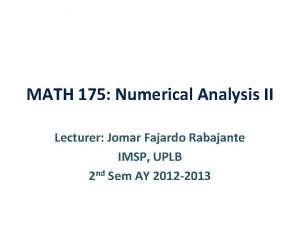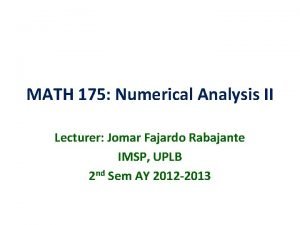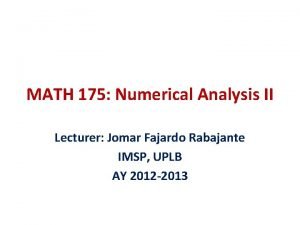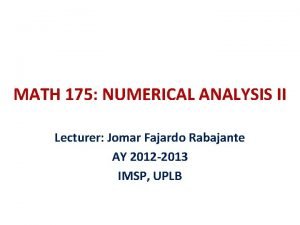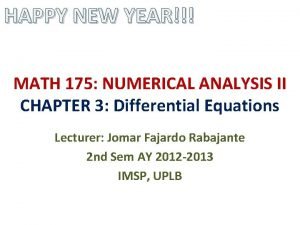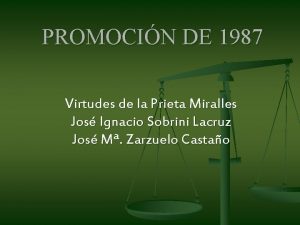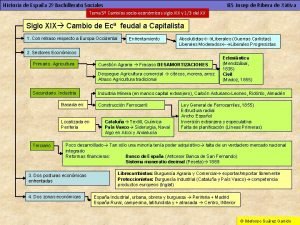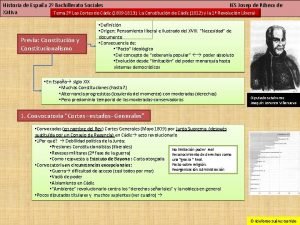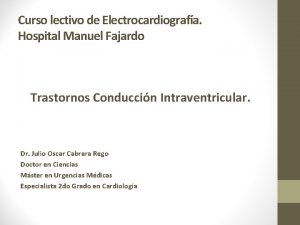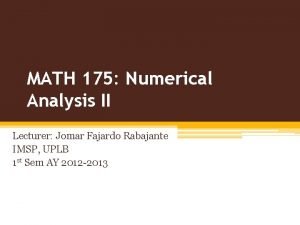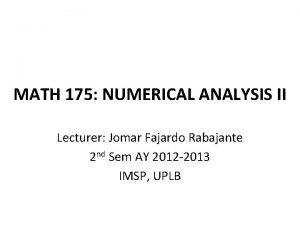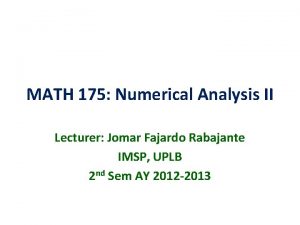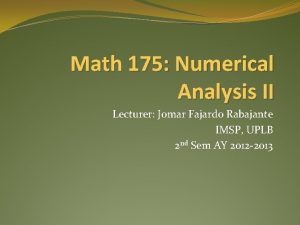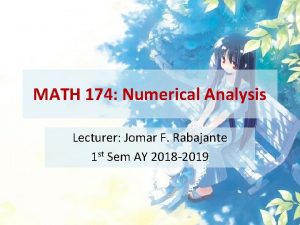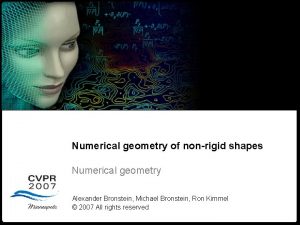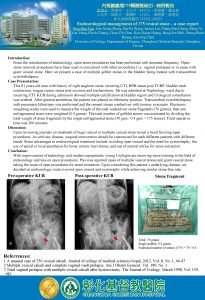MATH 175 Numerical Analysis II Lecturer Jomar Fajardo

























- Slides: 25

MATH 175: Numerical Analysis II Lecturer: Jomar Fajardo Rabajante IMSP, UPLB 2 nd Sem AY 2012 -2013

Question: • What if we do not have means of getting an initial bracket? Let’s start with SECANT METHOD… Suppose that f is a continuous function. Pick two initial points (not necessarily forming a bracket), then do linear interpolation (not inverse).

4 th Method: SECANT METHOD Initial points: Interpolating line: Use x-intercept:

4 th Method: SECANT METHOD Approximate: - Same as the formula for Regula Falsi - In an iteration, if the points form a bracket, then the method is similar to Regula Falsi; else the method uses extrapolation. In whatever case, the new points will be Old x 2

4 th Method: SECANT METHOD In short: Pick any two distinct points, draw the secant through them, and use the x-intercept (x 3) of that secant line as the new estimate of the zero of the function. For the next iteration, discard the oldest point and add (x 3, f(x 3)) as the new point. WE DO NOT NEED IZT (IVT) ANYMORE!






4 th Method: SECANT METHOD Secant method can be considerably faster than the previous methods. However, it may fail to converge. Example: if f(x 1)=f(x 2), then what would happen?

4 th Method: SECANT METHOD Notice that can be written as

4 th Method: SECANT METHOD and can also be written as You can use any of these formulas for Regula Falsi and Secant Method

4 th Method: SECANT METHOD For Secant Method (not for Regula Falsi), we can generalize the formulas as follows (k=1, 2, 3, …)

4 th Method: SECANT METHOD Example: Find a zero of Use 0 & 1 as initial values. =(A 1*(A 2^3+A 2 -1)A 2*(A 1^3+A 1 -1))/((A 2^3+A 21)-(A 1^3+A 1 -1)) =B 2 0 1 0. 5 0. 636363636 0. 690052356 0. 68202042 0. 682325781 0. 682327804 0. 682327804

4 th Method: SECANT METHOD Assuming that the secant method converges to the root, the order of convergence of the method is SUPERLINEAR!!! (but not yet quadratic)

4 th Method: SECANT METHOD Stopping criterion: You can use tol=10^(-m): accurate at least up to m decimal places

5 th Method: Newton’s Method/Newton-Raphson Iteration • What if we make the secant line is a tangent line? • Hence, we only need one initial point. • But we add another assumption: f should be differentiable!

5 th Method: Newton’s Method/Newton-Raphson Iteration From Secant Method: If we use tangent lines: as xk-2 approaches xk-1

5 th Method: Newton’s Method/Newton-Raphson Iteration Hence:





• Newton’s Method: To be continued… • Assignment: List the advantages and disadvantages of the discussed methods. Research other disadvantages that we did not mention in the class.
 Lecturer's name or lecturer name
Lecturer's name or lecturer name Math 175
Math 175 Math 175
Math 175 Math 175
Math 175 Math 175
Math 175 New year equation
New year equation Joaquín sagarra fernández-prida.
Joaquín sagarra fernández-prida. Walmart analysis report
Walmart analysis report Ariana fajardo orshan
Ariana fajardo orshan Walmart fajardo shopper
Walmart fajardo shopper Ies josep de ribera
Ies josep de ribera Ies josep de ribera
Ies josep de ribera Romeseta
Romeseta Physician associate lecturer
Physician associate lecturer Spe distinguished lecturer
Spe distinguished lecturer Good afternoon student
Good afternoon student Photography lecturer
Photography lecturer Lecturer in charge
Lecturer in charge Designation lecturer
Designation lecturer Designation of lecturer
Designation of lecturer Gcwak
Gcwak Lecturer name
Lecturer name Pearson lecturer resources
Pearson lecturer resources 140000/120
140000/120 Lector vs lecturer
Lector vs lecturer Lecturer in charge
Lecturer in charge

